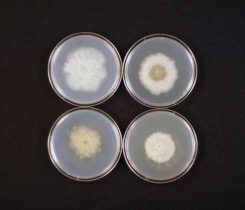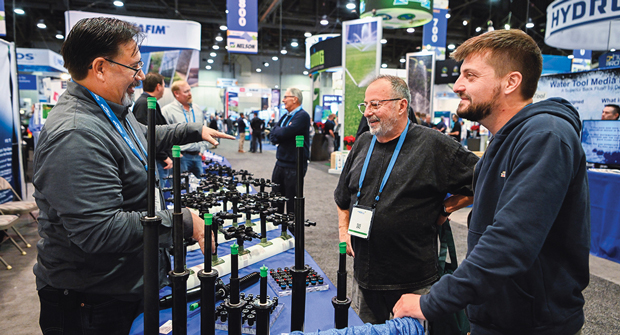Fungicides: From experiment to excellence
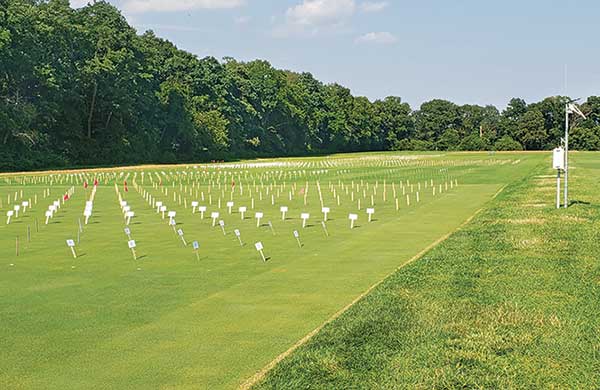
Rigorous field trials, like this one Bruce Clarke is conducting, can help evaluate a chemistry’s efficacy, rates and more. (Photo: Bruce Clarke)
When a chemical company releases a new chemistry such as a fungicide to the market, it typically has gone through years of rigorous testing by both the chemical company and universities around the country. It’s in this research where many innovations were made that impact golf courses today and that will impact courses in the future.
Researchers test these new fungicide chemistries in trials against a specific target disease at specified rates and intervals to determine the most efficacious way to utilize the product.
“We evaluate how well they work and how efficacious they are,” says Bruce Clarke, Ph.D., of these experimental compounds. Clarke, an Extension specialist in turfgrass pathology at Rutgers University, says companies rely on universities to evaluate new fungicides in rigorous field trials over a number of years before they are released and sold to turf managers.
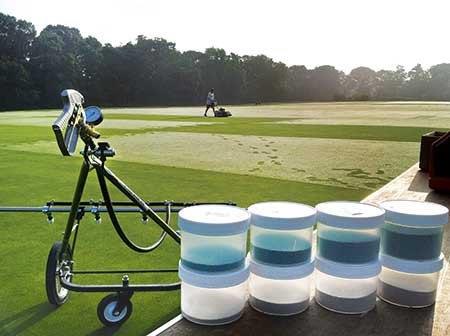
Cultural management practices often go hand in hand with fungicide trials to better target applications. (Photo: James Hepfling)
Generally, these experimental chemistries tackle a wide range of turf diseases known to plague golf course superintendents.
“Typically, this starts with the big four — dollar spot, brown patch, Pythium blight and anthracnose,” says Jim Kerns, Ph.D., associate professor and Extension specialist of turfgrass pathology at North Carolina State University. “If they pass muster there, then companies start looking at other areas where a fungicide may be useful.”
Kerns says sometimes researchers know what class of chemistry a fungicide belongs to, and sometimes they don’t. These experimental compounds are sent throughout the country to track their performance in different climates.
“The companies can look at an experimental product all day long in-house, but until they get it out in the hands of their collaborators in various geographies, they’re not going to know how it performs in different scenarios,” says David McCall, Ph.D., assistant professor and Extension specialist of turfgrass pathology at Virginia Tech. “That’s when we really start to know how a product can perform across the country in a lot of different regions. It might perform just as expected at most sites, but one location might reveal something that we, collectively, might not have ever considered.”
McCall estimates about half or more of his test plots are these experimental compounds not yet released.
“Out of every five numbered compounds, maybe three never make it beyond university testing because we find some flaws, either as being ineffective or as causing unintended negative consequences to the turfgrass,” McCall says. “Some of the best data that we can give a company is that negative information. They want to know the good, the bad and the ugly in every situation that we can come up with.”
Taking a broader look
However, if the experimental compound does perform as expected or better, the scope of the research expands. “This is actually the most fun for me,” Kerns says. “A lot of our cooperators will come to us and say, ‘hey, we have this material, and we’ve seen XYZ. Do you think there’s anything we should test it on?’”
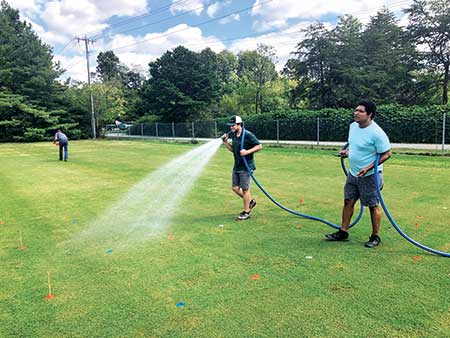
David McCall’s students conduct a post-application study with wetting agents
for control of spring dead spot. (Photo: David McCall)
Kerns says a great example of this is McCall’s research on PBI-Gordon’s Kabuto fungicide (isofetamid). McCall tested Kabuto for efficacy on dollar spot and included it in his research on spring dead spot, trialing SDHI chemistries, DMI chemistries and QoI chemistries.
“As innovation has it, Kabuto turns out to be one of the best spring dead spot materials that anyone has tested,” Kerns says. “It’s a nice partnership among the company and the researcher to try to figure out if there is an area that might be lacking.”
And it’s this relationship between chemical companies and university researchers that is important to fungicide innovation.
“They need us, and we need them,” Kerns says. “And in turn, that partnership is helping the end user.”
Ongoing research
Once released, university researchers have a wealth of information on a product from colleagues and data from their own trials to draw upon.
“It’s been studied by so many people for so long,” McCall says. “Our team may look at a product for five to seven years before it is released.”
Moreover, the research on released chemistries doesn’t stop.
“Once it’s labeled, we’re going to look at different rates, different timings, different diseases that may not be on the label,” Kerns says. “A lot of times, that actually comes from the golf course superintendent.”
Often, superintendents will use a fungicide for one disease such as fairy ring and anecdotally notice the absence of another disease such as takeall patch. So, researchers like McCall, Kerns and Clarke will take a closer look.
It’s in these post-release trials where researchers will take a deeper look at rates, too.
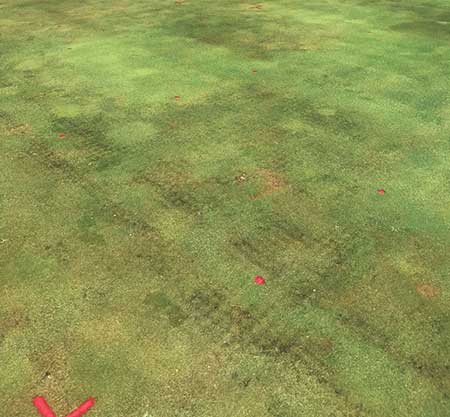
Jim Kerns’ Pythium root rot trial in 2018. The green spots indicate treatment with Segway or Union fungicides. (Photo: Jim Kerns)
“We’re continually working with (the companies) to try to refine how these materials are used,” Kerns says.
Kerns says the original label for Segway (cyazofamid) was a recommended rate of 0.45 to 0.9 fluid ounces in 2 to 4 gallons of water per 1,000 square feet. In his research, Kerns looked at lowering rates to maximize control. “Half the rate, 0.45, was outstanding,” Kerns says. “That gives golf course superintendent six applications of that material instead of three, and that innovation led to PBI-Gordon amending the label.”
Another innovation of note, Kerns says, is the inclusion of azoxystrobin, a QoI fungicide, w ith Segway’s cyazofamid.
“I think that product came from our research where we found that mixing Segway with a QoI fungicide improved its control especially in June, July and August,” he says. “It’s performed exceptionally well in our trials. (Also), it adds in a tank mixture, which is going to help reduce resistance risk from developing.”
Clarke says in his trials with Pythium blight, he has looked at a number of new chemistries over the years, and cyazofamid has been one of the most efficacious products he’s tested against this disease.
“It was a real game changer when we looked at cyazofamid, whose trade name is Segway,” Clarke says. “That product was one of the first materials that I’ve evaluated that consistently provided 14 days suppression of Pythium blight when conditions are really conducive to the disease.”
Cultural innovation
Moving beyond the innovation of fungicides application strategies, Clarke says when it comes to advancements and fungicides, “some of the biggest innovations have come from focusing on how best management practices influence disease development and fungicide efficacy.”
When cultural practices are optimized, Clarke says, fungicides work better and often at lower rates. Instead of curative treatments, superintendents who regularly scout their course for diseases, utilize disease models and employ best management practices can often successfully apply fungicides on an early curative, rather than preventive, basis.
Moreover, Kerns says his research has helped illustrate the key need for a wetting agent to increase the effectiveness of fungicides against diseases that attack the roots.
“Our research has clearly shown that post-application of irrigation is necessary at 1/8 inch. It has to be immediate, and (superintendents) need to be on a strong wetting agent program in order to facilitate the movement of the material to where this pathogen is,” he says. “Our work has helped clear the way because fungicides are not all that mobile; you still retain good protection of the foliage while moving a portion of that material down to protect the roots as well.”
Kerns says it’s important for superintendents to understand that the relationship university researchers have with chemical companies is vital to continued innovation in both product development and disease control.
“The companies are continuing to innovate and work with academics and themselves to show there’s a defined benefit with these materials,” he says.










